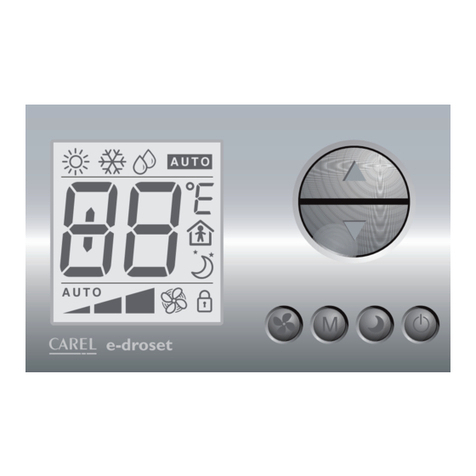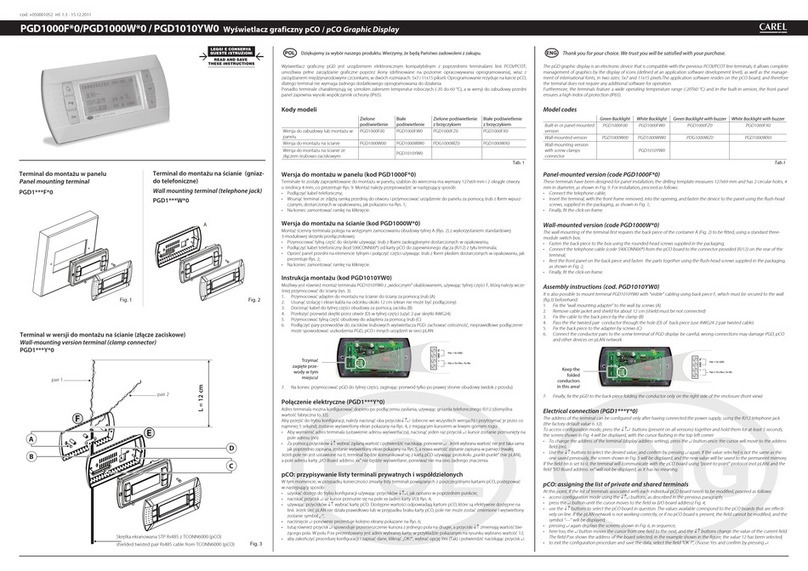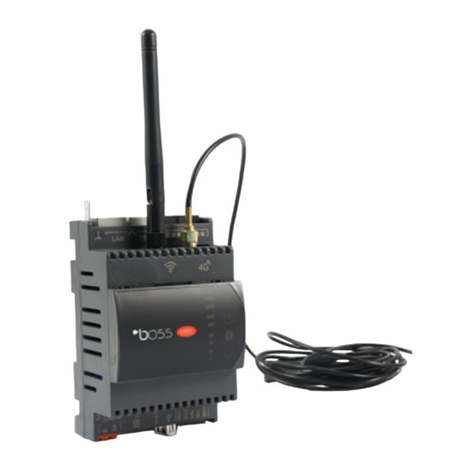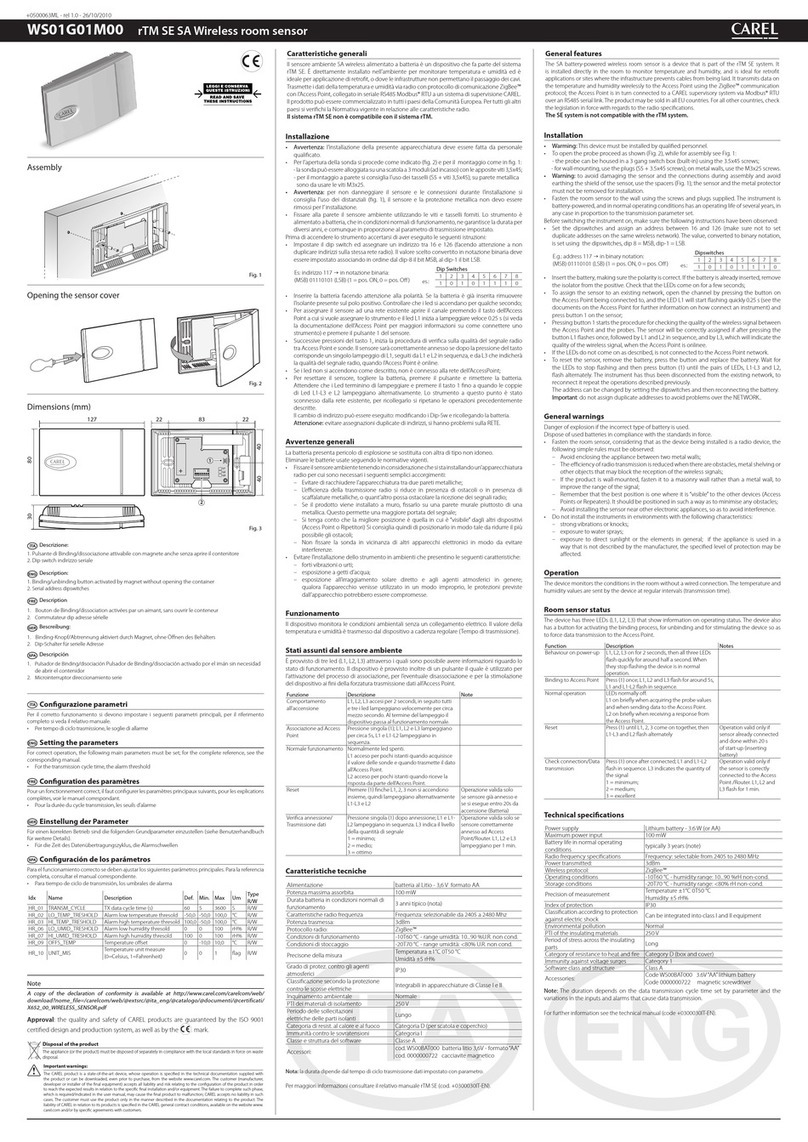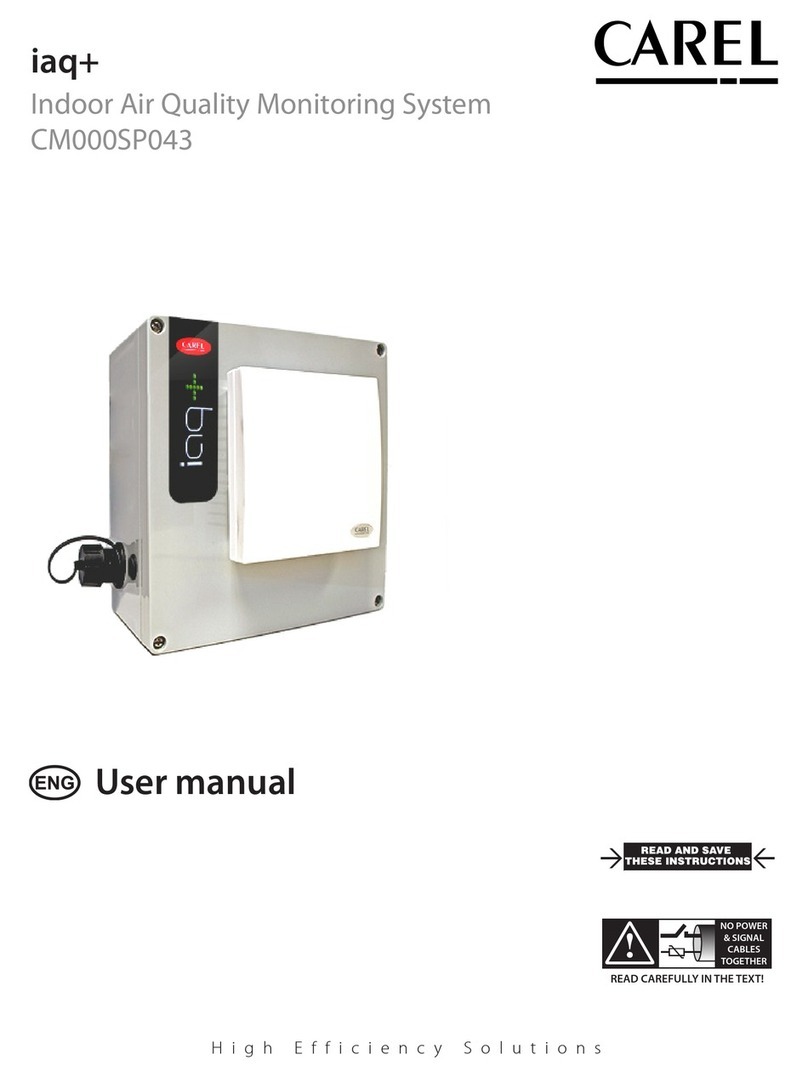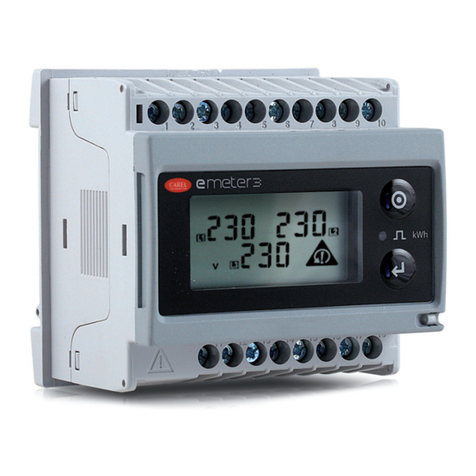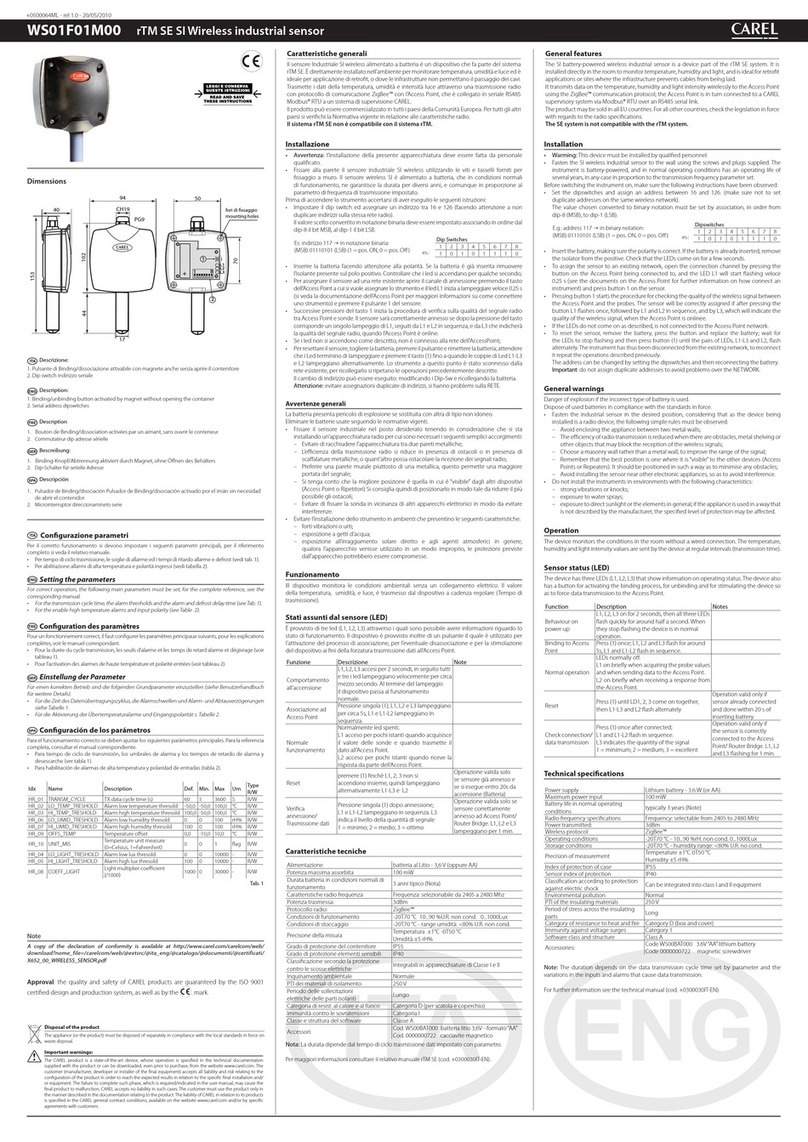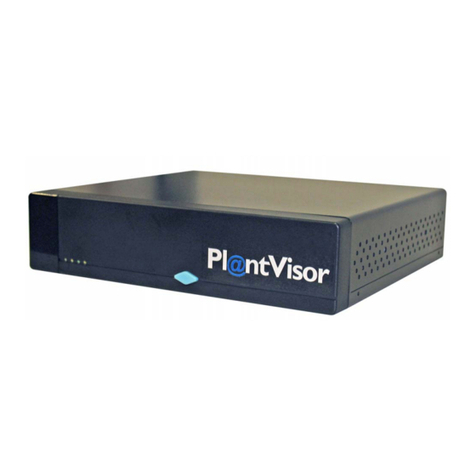CAREL S.p.A.
Via dell’Industria, 11 - 35020 Brugine - Padova (Italy)
Tel. (+39) 0499716611 – Fax (+39) 0499716600
CAREL si riserva la possibilità di apportare modifiche o cambiamenti ai propri prodotti senza alcun preavviso.
CAREL reserves the right to modify the features of its products without prior notice.
cod. +050000630 - rel. 3.2 - 14.03.2007
Caratteristiche tecniche
Alimentazione 15...36 Vcc; 24 Vca +/- 10%; 50-60 Hz
Alimentazione gas al sensore* diffusione
Assorbimento (uscite attive) • ASDQ100000: max. circa 120 mA
• ASDQ300000: max. circa 130 mA
Condizioni di immagazzinamento -20T60°C; 95% U.R. non condensante
Condizioni di funzionamento -10T50°C; 95% U.R. non condensante
Sensore VOC SnO2
Sensore CO2SnO2 sensore NDIR*
Range di misura CO2350...2000 ppm
Precisione misura CO2*+/- 30 ppm +/- 5% e.v.
Dipendenza dalla pressione* +/- 1,6% / kPa in relazione alla pressione standard
Stabilità a lungo termine* +/- 1% e.v./anno
Tempo di preriscaldamento per lettura valida* VOC: 5h (circa); CO2: 5 min. (circa)
Segnali d’uscita per VOC range di riferimento 0...100%
Tensione 0...10 V lineari per 0...100% di aria inquinata
corrente 0/4...20 V lineari per 0...100% di aria inquinata
Segnali d’uscita per CO2range di misura 350...2000 ppm
tensione 0...10 V lineari nel range di misura
Morsettiera morsetti a vite per cavi di sezione max. 1,5 mm2- min. 0,2 mm2
Grado di protezione versione da ambiente (ASWQ*) IP30 secondo DIN40050
versione da condotta (ASDQ*) IP65 secondo DIN40050
Normative CE: EN 60335-1: sicurezza
EN 60529: grado di protezione IP
EN 60730: dispositivi domestici
*: Caratteristiche valide solo per sonda ASWQ300000.
Misura e calibrazione della qualità dell’aria da parte del cliente
La vita dei sensori è limitata, basata sul loro modo di utilizzo in particolaredal tipo e dalla concentrazione dei gas presenti.
La misura della qualità dell’aria rivela la condizione generale dell’aria. Il segnale di uscita 0...10 Vcc è influenzato da gas differenti.
Esempi sono il fumo di sigaretta, spray deodoranti, detergenti, adesivi ecc.
L’apparecchio è fabbricato e calibrato per l’uso in stanze dove non ci siano esalazioni di gas. Il punto zero e la scala sono fissati in fabbrica tramite l’uso di aria sin-
tetica e una quantità fissa di idrogeno, rispettivamente. L’uso tipico dell’apparecchio è il rilevamento di cambiamenti della qualità dell’aria rispetto ad un punto zero
fissato. In alcuni casi (nuovi tappeti, pittura fresca...) la scala di misurazione può essere oltrepassata o si può verificare un carico eccessivo di gas sul sensore. In
questi casi il cliente deve calibrarsi l’apparecchio a seconda dell’ambiente circostante (in caso di calibrazione da parte del cliente reclami in garanzia non sono più
accettati).
Autocalibrazione della qualità dell’aria (default, jumper J2 per sensore VOC+CO2 e J3 per sensore VOC in posizione “AUTO“, vds.
collegamenti elettrici)
Il valore misurato si mantiene per 4 settimane. Dopo questo tempo il minore dei valori salvati è impostato al punto zero (uscita 1,0 V). La massima correzione è
limitata a 1 V ad ogni intervallo di 4 settimane. Gli effetti della deriva a lungo termine e dell’invecchiamento dell’elemento sensibile sono eliminati quasi
completamente. L’autocalibrazione funziona solo se si fornisce aria fresca al sensore almeno una volta in un intervallo di 4 settimane.
Calibrazione manuale della qualità dell’aria
La calibrazione manuale può iniziare premendo il pulsante “manual calibration” indipendentemente della posizione del jumper J2.Lo strumento deve funzionare con
“aria normale” per almeno 2 ore prima di inziare la calibrazione manuale. Premere il pulsante “manual calibration” per circa 5 s finchè il led non inizi a lampeggiare.
Ora l’uscita è automaticamente impostata a 1 V alle condizioni ambientali attuali. Durante la fase il led è acceso. Dopo aver concluso con successo la calibrazione,
il led si spegnerà. La calibrazione automatica è disattivata se il jumper J2 è in posizione “manual”.
Autocalibrazione del CO2 (default, jumper J3 in posizione “AUTO”, vds. collegamenti elettrici
L’apparecchio non ha bisogno di manutenzione perché è munito di un algoritmo di auto-correzione. Quest’ultimo mantiene in memoria il valore più basso rilevato
dal sensore durante 7,5 giorni ed effettua una lenta correzione in caso di importanti scostamenti rispetto al valore corrispondente all’aria fresca (400 ppm di CO2).
La procedura funziona bene solo se l’apparecchio riceve aria fresca (concentrazione di CO2 vicina a 400 ppm) per almeno 10 minuti ogni 7,5 giorni..
Calibrazione manuale di CO2
Dopo messa in tensione, l’apparecchio deve ricevere aria fresca (concentrazione di CO2 da 300 a 400 ppm) per almeno 10 minuti. La calibrazione manuale può
iniziare indipendentemente dalla posizione del jumper J3 premendo il tasto “Manual calibration CO2”. Premere il tasto “Manual calibration CO2” per almeno 5
secondi finché il led lampeggia, l’uscita viene allora settata a 1.75 V (350 ppm = punto zero) ed il led rimane acceso. Dopo aver concluso con successo la
calibrazione, il led viene spento.
Installazione
Per proteggere l’apparecchio contro collegamenti scorretti, si è utilizzato un diodo di protezione. Ciò permette di far funzionare l’apparecchio con un’alimentazione
24 Vca. Il segnale di uscita dev’essere misurato con strumento idoneo.Il segnale di uscita viene misurato rispetto allo zero del segnale d’ingresso. Se lo strumento
è alimentato in tensione continua, collegare l’ingresso 15...36 Vcc al terminale UB e la massa al terminale GND.
Se si alimentano a 24 Vca più apparecchi, tutti gli ingressi devono essere collegati alla stessa fase. Altrimenti si possono danneggiare. Tutte le uscite si devono
misurare allo stesso potenziale.
Smaltimento del prodotto
L'apparecchiatura (o il prodotto) deve essere oggetto di raccolta separata in conformità alle vigenti normative locali in materia di smaltimento.
AVVERTENZE IMPORTANTI
Il prodotto CAREL è un prodotto avanzato, il cui funzionamento è specificato nella documentazione tecnica fornita col prodotto o scaricabile, anche
anteriormente all’acquisto, dal sito internet www.carel.com.
Il cliente (costruttore, progettista o installatore dell’equipaggiamento finale) si assume ogni responsabilità e rischio in relazione alla fase di configurazione
del prodotto per il raggiungimento dei risultati previsti in relazione all’installazione e/o equipaggiamento finale specifico.
La mancanza di tale fase di studio, la quale è richiesta/indicata nel manuale d’uso, può generare malfunzionamenti nei prodotti finali di cui CAREL non potrà esse-
re ritenuta responsabile.
Il cliente finale deve usare il prodotto solo nelle modalità descritte nella documentazione relativa al prodotto stesso.
La responsabilità di CAREL in relazione al proprio prodotto è regolata dalle condizioni generali di contratto CAREL editate nel sito www.carel.com e/o da specifici
accordi con i clienti.
Technical specifications
Power supply 15 to 36 Vdc; 24 Vac +/- 10%, 50/60 Hz
Gas supply to the sensor* diffusion
Power input (active outputs) • ASDQ100000: around 120 mA max.
• ASDQ300000: around 130 mA max.
Storage conditions -20T60°C; 95% rH non-condensing
Operating conditions -10T50°C; 95% rH non-condensing
VOC sensor SnO2
CO2sensor SnO2 NDIR sensor*
CO2range of measurement 350 to 2000 ppm
CO2measurement precision* +/- 30 ppm +/- 5% e.v.
Pressure dependence* +/- 1.6% / kPa in relation to standard pressure
Long-term stability* +/- 1% e.v./year
Preheating time for valid reading* VOC: 5h (approx.); CO2: 5 min. (approx.)
Output signals for VOC range of reference 0 to 100%
voltage 0 to 10 V linear for 0 to 100% of polluted air
current 0/4 to 20 V linear for 0 to 100% of polluted air
Output signals for CO2range of measurement 350 to 2000
voltage 0 to 10 V linear in the range of measurement
Terminal block screw terminals for wires with max. cross-section 1.5 mm2, - min. 0.2 mm2
Index of protection room version (ASWQ*) IP30 as per DIN40050
duct version (ASDQ*) IP65 as per DIN40050
CE standards: EN 60335-1: safety
EN 60529: IP index of protection
EN 60730: household devices
*: Characteristics valid only for sensor code ASWQ300000.
Measurement and calibration of air quality by the customer
The lifetime of the sensors is limited based on their working principle. It depends from kind and concentration of the gas effects on the sensor.
The measurement of air quality detects the general condition of air. The output signal of 0…10V is influenced by different gases.
Examples are cigarette smoke, deodorant sprays, detergents, adhesives etc.
The apparatus is made and calibrated for use in rooms where gas-phase stripping has finished. The zero point and the measurement range are fixed by factory by
use of synthetic air and a fixed amount of hydrogen, respectively. The standard use of the apparatus is the detection of changes of the air quality related to the
fixed zero point. There can appear an overstep of the measurement range or a high base-load of the apparatus in some cases (new carpets, fresh paint etc.).
The customer himself has to calibrate the apparatus according to the circumstances of use in those cases. (Notice, all claims under guarantee will be null and void
after customers calibration of the unit).
Automatic self-calibration of air quality (default, jumper J2 in position “AUTO“, see electrical wirings)
The measurement value of air quality is saved about 4 weeks. After that time the minimum of the saved values is set to zero point (output 1,0V). The maximum
correction is limited to 1V at each interval of four weeks. Long term drift and aging effects of the sensor element are eliminated almost completely.
The autocalibration only works if fresh air is supplied to the sensor at least once in an interval of four weeks.
Manual calibration of air quality
The manual calibration can be started by pressing the button “manual calibration“ at each position of jumper J3. The instrument should have been operated for at
least 2 hours at “normal air“ before starting the manual calibration. Press the button “manual calibration“ for about 5 sec until the LED starts to flash. Now the
output is automatically set to 1V at the actual environmental conditions. During that process the LED is on. After finishing the calibration succesfully, the LED will
be shut off. The automatic selfcalibration is deactivated if jumper J3 is in position “manual“.
Automatic self- calibration of CO2 (default, jumper J3 in position „AUTO“ , see electrical wirings)
The sensor unit is maintenance free in normal environments because of an implemented automatically running selfcorrecting algorithm. This algorithm keeps track
of the sensor’s lowest reading over a 7.5 days interval and slowly corrects for any long term drift detected as compared to the expected fresh air value of 400ppm
CO2. The procedure works well only if the apparatus is supplied with fresh air (CO2 - concentration about 400ppm) for at least ten minuts in the self-calibration
time interval of 7.5 days.
Manual calibration of CO2
Manual calibration can be started independently from the position of jumper J3 by pushing the button. After connecting the device, a period of at least 10 minutes
of continuous operation of the device at fresh air (CO2 content 300ppm … 400ppm) is to be ensured. Manual calibration of the output signal to 1,75V
(350ppm = zeropoint) is started by pressing the button “Manual calibration CO2” (for ca. 5 seconds). Preparing for calibration is indicated by a blinking LED.
Setting the output to 1,75V at actual ambient conditions follows automatically there after. During this phase, the LED is permanently activated.After calibration is
completed, the LED is deactivated.
Installation
To protect the instrument against incorrect polarity, a protection diode is used. This allows to run the instrument with a 24 Vac power supply. Its output signal has to
measured with a suitable measuring instrument. The ouput signal is measured against the zero potential of the input voltage.If the instrument is operated with
DC-power supply, connect the15…36 Vdc input to the UB terminal and the ground to the GND terminal.
If several instruments are supplied by a 24 Vac power supply, all inputs have to be connected in the same phase. Otherwise all instruments could be damaged.
All outputs have to be measured against the same potential.
Disposal of the product
The appliance (or the product) must be disposed of separately in compliance with the local standards in force on waste disposal.
IMPORTANT WARNINGS
The CAREL product is a state-of-the-art device, whose operation is specified in the technical documentation supplied with the product or can be downloaded, even
prior to purchase, from the website www.carel.com.
The customer (manufacturer, developer or installer of the final equipment) accepts all liability and risk relating to the configuration of the product in order to
reach the expected results in relation to the specific installation and/or equipment. The failure to complete such phase, which is required/indicated in the
user manual, may cause the final product to malfunction; CAREL accepts no liability in such cases.
The customer must use the product only in the manner described in the documentation relating to the product.
The liability of CAREL in relation to its products is specified in the CAREL general contract conditions, available on the website www.carel.com and/or by specific
agreements with customers.
Esempi di collegamento /
Examples of connection

